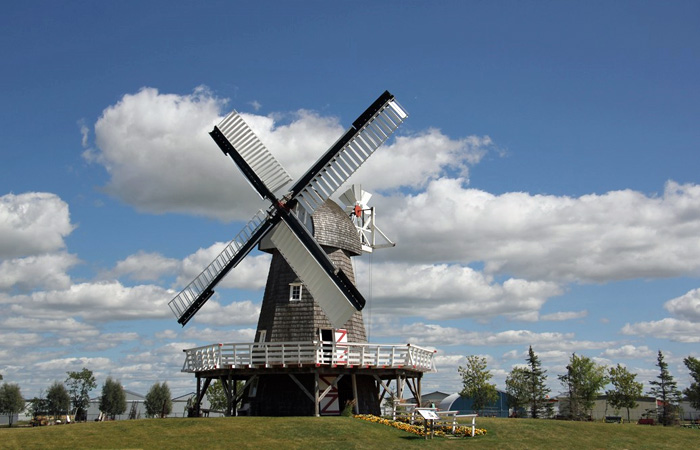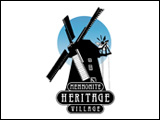The Mennonite Heritage Village (MHV) windmill, our signature building, is a replica of the largest of four windmills built in the Steinbach area in the years 1876 to 1878. The original Smock type windmill, was built in 1877. Peter K. Barkman, a millwright and miller from Russia, built the structure for A.S. Friesen, one of the community founders. The logs used for the cornerposts were cut in the La Broquerie-Marchand area and nearly all the parts, including those of iron, were manufactured locally.
In the first years settlers in the Steinbach area had their wheat milled in Winnipeg, which probably felt wrong to their local savings instinct. So, it only took a couple of years before the windmill became a priority build. First Semlins for survival, then when finances allowed housebarns for expansion and next the community windmill. It showed to the Mennonite pioneers that they were truly settling in.
However, this building communicates much more than just a Dutch-Germanic settlement on Canadian prairies. The windmill sails were also used to communicate newsworthy items to the surrounding community.
In a traditional Mennonite village, the windmill was the tallest building, it could be seen by all the villagers as well as farmers in the surrounding countryside. Therefore, the miller would use the position of the sails to communicate messages afar.
If the sails were stopped in an X formation (ten o’clock, two o’clock), that would mean no milling, probably not enough wind or the miller would be off duty. If the sails had been moving and they were parked in a straight up and down position (twelve o’clock),that would mean the miller was having a short break and would resume shortly. If the sails were parked at a one o’clock position, they told of a happy event such as a birth or a wedding. Parked in the eleven o’clock position would indicate an occasion for mourning, perhaps a death had occurred or a serious accident or illness.
Did you know that, the windmill at MHV is the only wind operational windmill in all of Canada?!? Another unique feature is that addition of the fantail. Most windmills in the world do not have a fantail. However, this small fan at the rear of the cap automatically turns the cap so the sails always face the direction of the wind. When I do my museum rounds in the dead of winter it always gets a second look from me as it is the only thing that has moved since I was on the grounds last. It makes the building feel eerily alive.
MHV volunteers mill approximately 3000 pounds a summer. About half of that is used to bake the bread served at our Livery Barn Restaurant, and the other half is sold in three-pound bags to people who visit our gift shop. MHV flour is natural stone-ground flour with no additives or preservatives. Our restaurant is still offering take-out this week, including traditional bread made with windmilled flour. Taste your windmill heritage!




